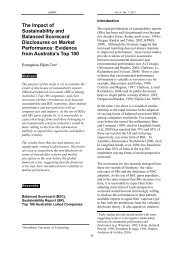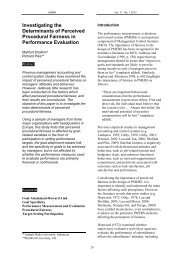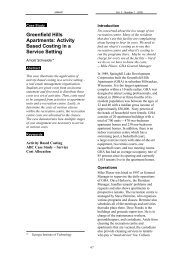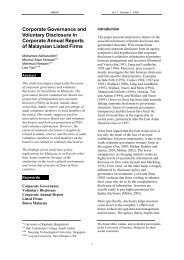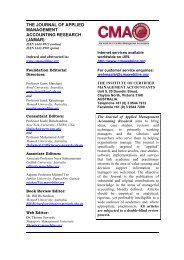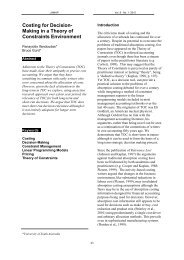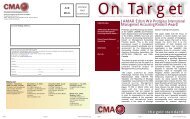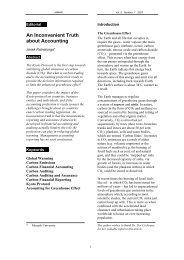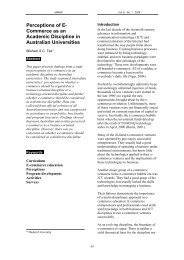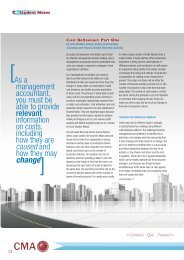Recognition of Idle Resources in Time-Driven Activity-Based ...
Recognition of Idle Resources in Time-Driven Activity-Based ...
Recognition of Idle Resources in Time-Driven Activity-Based ...
Create successful ePaper yourself
Turn your PDF publications into a flip-book with our unique Google optimized e-Paper software.
JAMAR Vol. 7 · Number 2 · 2009manage product costs by chang<strong>in</strong>g quantities<strong>of</strong> organisational outputs. Under traditionalvolume-based cost<strong>in</strong>g models and the ABCmodel, costs associated with idle resources areallocated to cost objects. Product costs are<strong>in</strong>flated and management may accidentallystart the fixed cost death spiral by remov<strong>in</strong>gproducts or services that consume fewerresources than they appear to consume (van deMerwe and Keys, 2001). By remov<strong>in</strong>g impacts<strong>of</strong> idle resources on product costs, TDABCand RCA models enable cost managementsystems to provide more accurate <strong>in</strong>formationon product costs (Benjam<strong>in</strong> and Simon, 2003;Kaplan and Anderson, 2004).The ABC model differentiates itself fromtraditional volume-based cost<strong>in</strong>g models byenabl<strong>in</strong>g cost management systems to provide<strong>in</strong>formation on how operat<strong>in</strong>g activities addvalue to organisational outputs throughl<strong>in</strong>kages between resource pools and cost pools(type 2 <strong>in</strong>formation). With this type <strong>of</strong><strong>in</strong>formation, management can reduce productcosts by reduc<strong>in</strong>g or elim<strong>in</strong>at<strong>in</strong>g non valueaddedactivities (Gossel<strong>in</strong>, 1997). As both theTDABC and RCA models adopt activity-basedparadigm <strong>in</strong> the models, cost managementsystems that are based on the two models canalso provide <strong>in</strong>formation on l<strong>in</strong>kages betweenresource pools and cost pools.While adoption <strong>of</strong> the ABC model enablesmanagement to elim<strong>in</strong>ate non value-addedactivities by us<strong>in</strong>g <strong>in</strong>formation on howoperat<strong>in</strong>g activities add value to organisationaloutputs, it provides little <strong>in</strong>sights on howvalue-added activities can be managed. In theTDABC and RCA models, provision <strong>of</strong><strong>in</strong>formation on idle resources effectively fillsthis gap.As idle resources do not make directcontributions to operat<strong>in</strong>g activities, theirexistence represents <strong>in</strong>efficiencies <strong>in</strong> anorganisation’s operations. Management canimprove operational efficiency by reduc<strong>in</strong>gquantities <strong>of</strong> idle resources. <strong>Idle</strong> resources canbe reduced by either <strong>in</strong>creas<strong>in</strong>g organisationaloutputs or reduc<strong>in</strong>g quantities <strong>of</strong> committedresources (Buchheit, 2003). By provid<strong>in</strong>g<strong>in</strong>formation on idle resources <strong>in</strong> resourcepools, TDABC and RCA models enablemanagement to improve an organisation’sefficiency <strong>in</strong> perform<strong>in</strong>g its value-addedactivities.Table 1: Comparison <strong>of</strong> TDABC and RCA models<strong>Time</strong>-<strong>Driven</strong> <strong>Activity</strong><strong>Based</strong> Cost<strong>in</strong>gRelationship with other System <strong>in</strong>dependent<strong>in</strong>formation systemsOrganisation <strong>of</strong> resource Cost-based resource poolspoolsComposition <strong>of</strong> resource All resource costs arepoolsvariableCross-allocation <strong>of</strong> resource No cross allocation amongcosts among resource poolsAllocation <strong>of</strong> resource coststo cost objectsresource pools<strong>Activity</strong>-based costallocationResource ConsumptionAccount<strong>in</strong>gERP-compliantTechnology-based resourcepoolsResource costs can be eitherfixed or variableCross allocation amongresource pools is allowedBoth activity-based andvolume-based cost allocationare allowedTDABC and RCA Models <strong>in</strong> Action –Department MDepartment MIn this section, an ABC-based cost<strong>in</strong>g modelfor a hypothetical production department isconverted to two cost<strong>in</strong>g models that are basedon the TDABC model and the RCA modelrespectively. The two new cost<strong>in</strong>g models arethen used to allocate resource costs to itsproducts.Department M is a hypothetical productiondepartment <strong>in</strong> a manufactur<strong>in</strong>g firm. It is anautonomous organisational unit that <strong>in</strong>volves<strong>in</strong> production <strong>of</strong> three products, namelystandard, deluxe and premium.45




